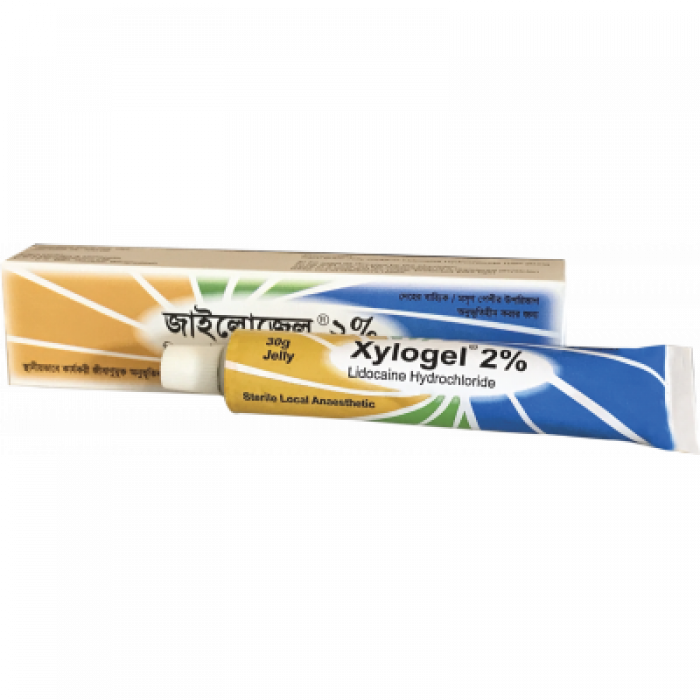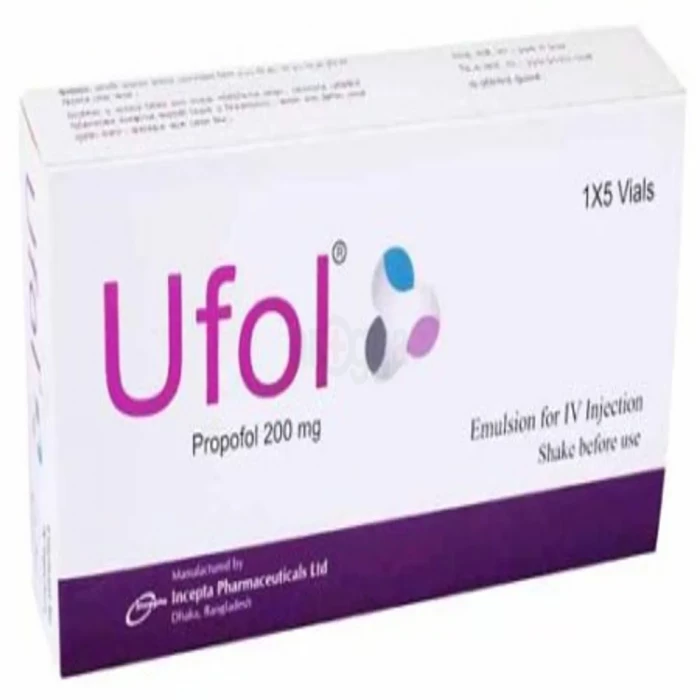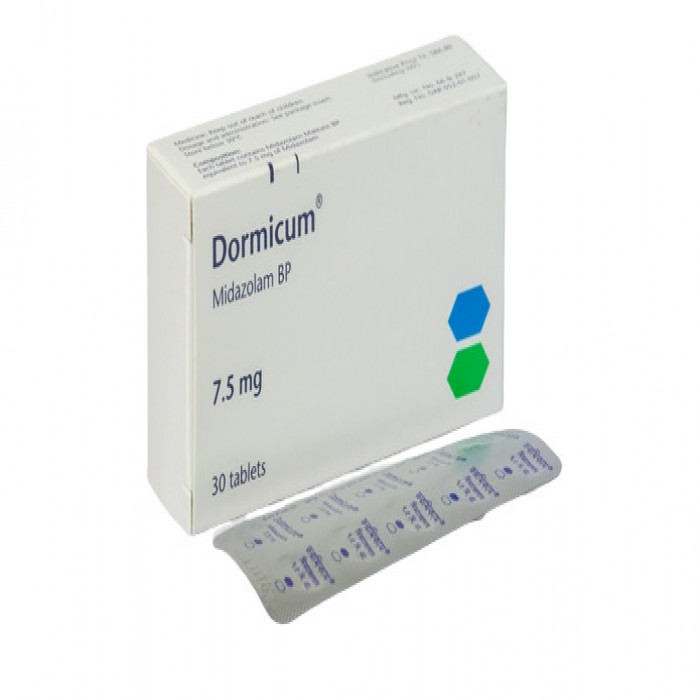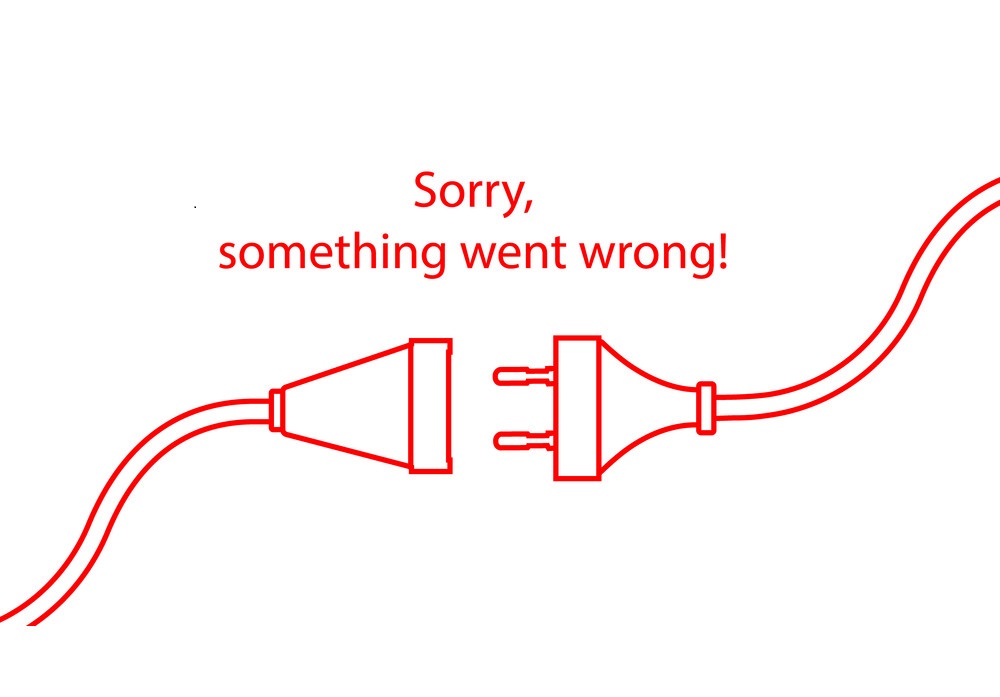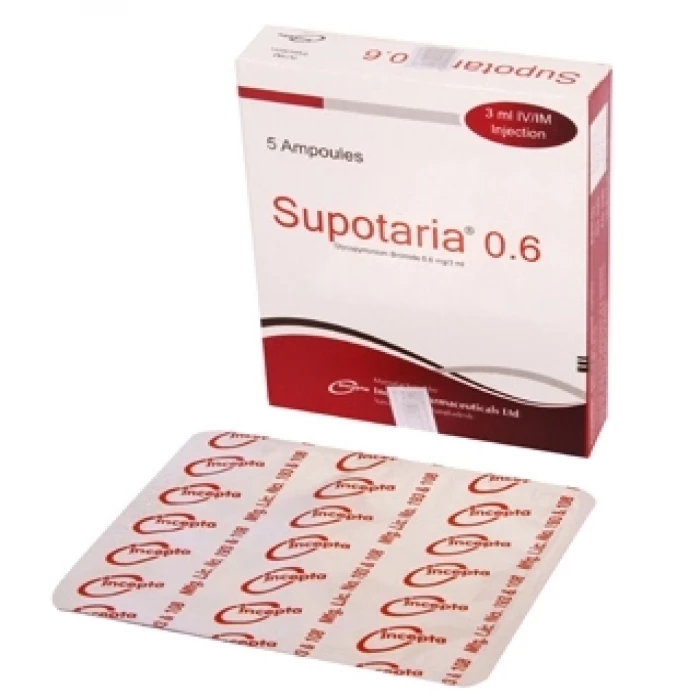
✔ 100% Authentic Product
👁️ Currently Viewing 2314
Supotaria IM/IV 0.6mg/3ml Injection 1pc
Glycopyrronium bromide is a versatile antimuscarinic agent used in various medical contexts, particularly in anesthesia to manage secretions and heart rate, and as an adjunctive therapy for peptic ulcers when rapid effects are necessary. Its utility extends to managing hyperhidrosis, sialorrhea, and symptoms associated with cerebral palsy.
Discount
Price: ৳ 86
MRP:
৳
90
4%
Off

100% Genuine Products, Guaranteed

Safe & Secure Payments, Always

Fast, Secure & Efficient Delivery

Proper Packaging
 Cash on Delivery - All over Bangladesh
Cash on Delivery - All over Bangladesh Regular Delivery - 12-24 Hours, Dhaka City* Charge Tk.39-59
Regular Delivery - 12-24 Hours, Dhaka City* Charge Tk.39-59 Regular Delivery - 24-48 Hours, Other Cities* Charge Tk.99-110
Regular Delivery - 24-48 Hours, Other Cities* Charge Tk.99-110
 ফ্রি ডেলিভারিঃ - ৯৯৯ টাকা+ অর্ডারে, ঢাকা
শহরে
ফ্রি ডেলিভারিঃ - ৯৯৯ টাকা+ অর্ডারে, ঢাকা
শহরে ফ্রি ডেলিভারিঃ - ২৯৯৯ টাকা+ অর্ডারে, ঢাকার
বাহিরে
ফ্রি ডেলিভারিঃ - ২৯৯৯ টাকা+ অর্ডারে, ঢাকার
বাহিরে
100% Genuine Products, Guaranteed
Safe & Secure Payments, Always
Fast, Secure & Efficient Delivery
Proper Packaging
 Cash on Delivery - All over Bangladesh
Cash on Delivery - All over Bangladesh Regular Delivery - 12-24 Hours, Dhaka City* Charge Tk.39-59
Regular Delivery - 12-24 Hours, Dhaka City* Charge Tk.39-59 Regular Delivery - 24-48 Hours, Other Cities* Charge Tk.99-110
Regular Delivery - 24-48 Hours, Other Cities* Charge Tk.99-110 ফ্রি ডেলিভারিঃ - ৯৯৯ টাকা+ অর্ডারে, ঢাকা
শহরে
ফ্রি ডেলিভারিঃ - ৯৯৯ টাকা+ অর্ডারে, ঢাকা
শহরে ফ্রি ডেলিভারিঃ - ২৯৯৯ টাকা+ অর্ডারে, ঢাকার
বাহিরে
ফ্রি ডেলিভারিঃ - ২৯৯৯ টাকা+ অর্ডারে, ঢাকার
বাহিরে
✅ Description:
Chronic Obstructive Pulmonary Disease (COPD) is a group of progressive lung diseases that obstruct airflow and make breathing difficult. The primary diseases classified under COPD are emphysema and chronic bronchitis.
Types of COPD
Emphysema: This condition involves damage to the air sacs (alveoli) in the lungs, leading to shortness of breath. The alveoli are responsible for the exchange of oxygen and carbon dioxide in the lungs. In emphysema, these sacs are damaged and lose their elasticity, making it hard to breathe.
Chronic Bronchitis: This condition is characterized by inflammation of the lining of the bronchial tubes, which carry air to and from the lungs. It results in persistent coughing and the production of mucus.
- The most significant risk factor for COPD is long-term smoking. Tobacco smoke irritates the airways and damages lung tissue.
- Long-term exposure to air pollutants, fumes, chemicals, and dust can also contribute to the development of COPD.
- A rare genetic disorder called alpha-1 antitrypsin deficiency can cause COPD, even in non-smokers.
- A persistent cough that produces mucus.
- Difficulty breathing, especially during physical activities.
- A whistling or squeaky sound while breathing.
- A feeling of constriction or tightness in the chest.
- People with COPD are more susceptible to colds, the flu, and pneumonia.
- COPD is diagnosed through a combination of patient history, physical examination, and tests such as spirometry (a lung function test), chest X-rays, and CT scans.
- While there is no cure for COPD, its symptoms can be managed through medications (like bronchodilators and steroids), pulmonary rehabilitation, lifestyle changes (quitting smoking, avoiding lung irritants), and, in severe cases, oxygen therapy or surgery.
- The most effective way to prevent COPD or slow its progression is to quit smoking.
- Minimize exposure to secondhand smoke, air pollution, and occupational dust and chemicals.
- Early detection and management of COPD can improve quality of life and slow disease progression.
Safety Advices

UNSAFE
You are advised not to consume alcohol while using Supotaria IM/IV 0.6mg/3ml Injection as it might cause increased dizziness.

Pregnancy
CONSULT YOUR DOCTOR
Please consult your doctor if you have any concerns; your doctor will prescribe only if the benefits outweigh the risks.
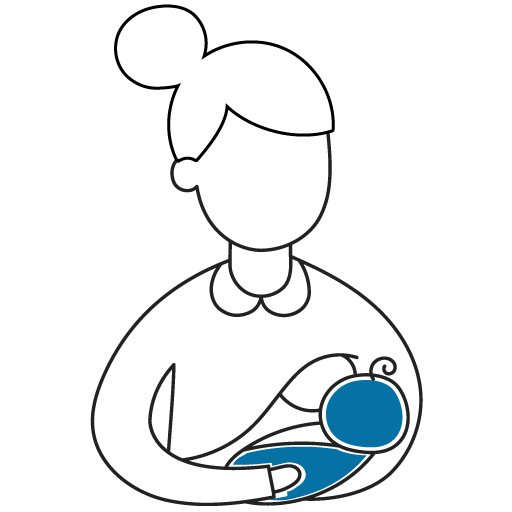
Breastfeeding
CONSULT YOUR DOCTOR
Consult your doctor before using Supotaria IM/IV 0.6mg/3ml Injection; your doctor will decide whether or not Supotaria IM/IV 0.6mg/3ml Injection can be used by breastfeeding mothers.

Driving
CAUTION
Supotaria IM/IV 0.6mg/3ml Injection may cause dizziness. Drive or operate machinery only if you are alert.
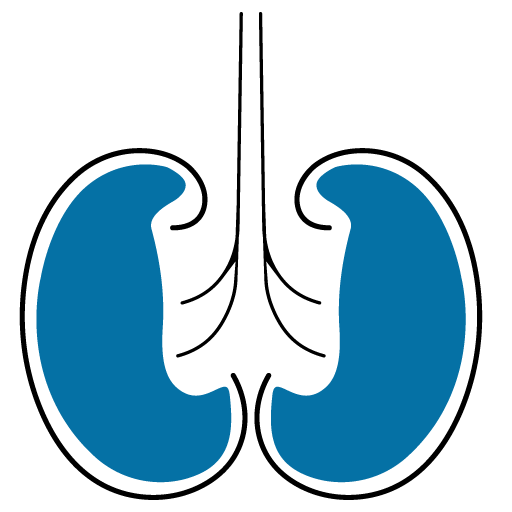
Kidney
CONSULT YOUR DOCTOR
Dose adjustment may be needed. Please consult your doctor before using Supotaria IM/IV 0.6mg/3ml Injection if you have liver impairment/liver disease or any concerns regarding this.

Liver
CAUTION
Dose adjustment may be needed. Please consult your doctor before using Supotaria IM/IV 0.6mg/3ml Injection if you have kidney impairment/kidney disease or any concerns regarding this.
✔️ Uses of Supotaria IM/IV 0.6mg/3ml Injection
- Chronic Obstructive Pulmonary Disease (COPD)
✔️ How does Supotaria IM/IV 0.6mg/3ml Injection work?
Glycopyrronium is an anti-cholinergic that decreases the secretions in the airways.
✔️ Side Effects of Supotaria IM/IV 0.6mg/3ml Injection
- Headache
- Dizziness
- Dry mouth
- Nausea
- Chest pain
- Muscle cramps
- Anxiety
✔️ Quick Suggestions:
- Eat a healthy diet and exercise regularly to strengthen your breathing muscles and boost your immune system.
- Avoid foods such as cabbage, beans, garlic, onions, shrimp, pickled food, dried fruits, fried foods, carbonated drinks, wine, bottled lemon, and lime juice as it may worsen symptoms.
- Do meditation, deep breathing, regular exercise and try progressive muscle relaxation techniques to get relief from stress and reduce the risk of an attack.
- Quit smoking as it may reduce the effectiveness of Glycopyrronium Bromide, irritate the lungs, and worsen breathing problems.
- Learn breathing exercises like pursed-lip breathing. It helps provide relief from COPD.
✔️ Indication of Supotaria IM/IV 0.6mg/3ml Injection
In Anesthesia:
Pre-operative Antimuscarinic Agent:
- Purpose: Reduces salivary, tracheobronchial, and pharyngeal secretions.
- Additional Effect: Reduces the acidity of gastric contents.
Pre-operative or Intra-operative Antimuscarinic:
- Purpose: Attenuates or prevents intra-operative bradycardia.
- Context: Effective using suxamethonium or due to cardiac vagal reflexes.
Protection Against Muscarinic Actions of Anticholinesterases:
- Purpose: Counters peripheral muscarinic effects of neostigmine and pyridostigmine.
- Context: Used to reverse residual neuromuscular blockade from non-depolarizing muscle relaxants.
In Peptic Ulcer:
- Purpose: Adjunctive therapy for treating peptic ulcers.
- Context: Used when a rapid anticholinergic effect is needed or when oral medication is not tolerated.
Other Indications:
Hyperhidrosis:
- Purpose: Reduces excessive sweating.
Sialorrhea:
- Purpose: Manages excessive saliva production.
Cerebral Palsy:
Purpose: Used to manage various symptoms associated with cerebral palsy, particularly those related to excessive secretions.
✔️ Pharmacology
Glycopyrronium Bromide is a quaternary ammonium antimuscarinic agent primarily used in anesthetic practice for its peripheral effects.
Pre-anesthetic Medication:
- Purpose: Reduces the risk of vagal inhibition of the heart and diminishes salivary and bronchial secretions.
- Administration: Given before general anesthesia to prepare the patient by minimizing secretions and stabilizing heart function.
Intraoperative Use:
- Purpose: Reduces bradycardia and hypotension induced by anesthetic agents like suxamethonium, halothane, or propofol.
- Administration: Administered during surgery to manage heart rate and blood pressure.
Reversal of Neuromuscular Blockade:
- Purpose: Prevents muscarinic side effects (e.g., bradycardia, salivation) associated with anticholinesterases like neostigmine.
- Administration: Given before or with anticholinesterases to counteract their adverse effects.
Mechanism of Action
- Competitive Inhibition: Antimuscarinic drugs like glycopyrronium bromide competitively inhibit the action of acetylcholine at muscarinic receptors in autonomic effector sites innervated by parasympathetic (cholinergic postganglionic) nerves.
- Peripheral Antimuscarinic Effects:
- Decreased Secretions: Reduces production from salivary, bronchial, and sweat glands.
- Ocular Effects: Causes pupil dilation (mydriasis) and paralysis of accommodation (cycloplegia).
- Cardiac Effects: Increases heart rate.
- Gastrointestinal Effects: Inhibits micturition, reduces gastrointestinal tone, and decreases gastric acid secretion.
- Central Effects: Minimal central effects due to poor lipid solubility and limited passage through the blood-brain barrier.
✔️ Glycopyrronium Bromide Dosage and Administration
Pre-anesthetic Use
Adults:
- Dosage: 0.2 mg to 0.4 mg intravenously (IV) or intramuscularly (IM) before the induction of anesthesia.
- Alternative Dosage: 0.004 to 0.005 mg/kg, up to a maximum of 0.4 mg.
- Note: Larger doses may result in a profound and prolonged antisialogogue effect, which may be unpleasant for the patient.
Children (1 month to 12 years of age):
- Dosage: 0.004 to 0.008 mg/kg, up to a maximum of 0.2 mg IV or IM before the induction of anesthesia.
- Note: Larger doses may result in a profound and prolonged antisialogogue effect, which may be unpleasant for the patient.
Intraoperative Use
When used to treat arrhythmias associated with traction reflexes, standard procedures should be followed to determine the etiology of the arrhythmia and correct parasympathetic imbalance.
Adults:
- Dosage: A single dose of 0.2 to 0.4 mg (or 0.004 to 0.005 mg/kg, up to a maximum of 0.4 mg) by IV injection.
- Repeat Dosage: This dose may be repeated if necessary.
Children (1 month to 12 years of age):
- Dosage: A single dose of 0.004 to 0.008 mg/kg, up to a maximum of 0.2 mg by IV injection.
- Repeat Dosage: This dose may be repeated if necessary.
Reversal of Neuromuscular Blockade
Adults:
- Standard Dosage: 0.2 mg IV per 1 mg neostigmine or the equivalent dose of pyridostigmine.
- Alternative Dosage: 0.01-0.015 mg IV with 0.05 mg/kg neostigmine or equivalent dose of pyridostigmine.
- Method of Administration: Glycopyrronium may be administered simultaneously from the same syringe with the anticholinesterase for greater cardiovascular stability.
Children (1 month to 12 years of age):
- Dosage: 0.01 mg/kg IV with 0.05 mg/kg neostigmine or the equivalent dose of pyridostigmine.
- Method of Administration: Glycopyrronium may be administered simultaneously from the same syringe with the anticholinesterase for greater cardiovascular stability.
✔️ Drug Interactions Involving Antimuscarinic Agents
Antimuscarinic agents, also known as anticholinergic drugs, inhibit the action of acetylcholine on muscarinic receptors. These agents are used for various therapeutic purposes, including the treatment of respiratory, gastrointestinal, and neurological conditions. However, their use can lead to significant drug interactions, resulting in exacerbated side effects and altered drug efficacy.
General Antimuscarinic Effects
- Dry Mouth, Urine Retention, and Constipation: Concomitant use of two or more antimuscarinic drugs can amplify these side effects.
- Confusion in the Elderly: Elderly patients are particularly susceptible to confusion due to the combined antimuscarinic load.
- Delayed Absorption of Other Medications: Anticholinergic agents can slow gastrointestinal motility, delaying the absorption of concomitant medications.
- Increased Intraocular Pressure: Concurrent use of corticosteroids can raise intraocular pressure, posing a risk to patients with glaucoma.
- Increased Serum Digoxin Levels: The use of anticholinergic agents with slow-dissolving digoxin tablets can result in elevated digoxin levels due to reduced gastrointestinal motility.
Specific Drug Interactions
- Ritodrine
- Amantadine, Tricyclic Antidepressants, Antihistamines, Clozapine, Disopyramide, MAOIs, Nefopam, Pethidine, and Phenothiazines
- Domperidone/Metoclopramide
- Ketoconazole
- Levodopa
- Memantine
- Nitrates
- Parasympathomimetics:
✔️ Contraindications
Do not use Supotaria IM/IV 0.6mg/3ml Injection if you are allergic to any of its contents.
✔️ Pregnancy & Lactation
Data on the use of glycopyrronium bromide in pregnant women, other than on delivery, are not forthcoming, nor is there documentation concerning excretion in breast milk. Although glycopyrronium bromide does not readily cross the placenta, the injection should only be prescribed to pregnant women when clearly necessary. Caution is advised when considering administration to a lactating mother.
✔️ Precautions & Warnings
- Keep regular appointments with your doctor to monitor your COPD and adjust treatment as necessary.
- Incorporate lifestyle changes such as quitting smoking, avoiding lung irritants, and following a pulmonary rehabilitation program to enhance the effectiveness of your COPD management.
✔️ Storage Conditions:
Store in a cool and dry place away from sunlight
⚠️Disclaimer:
At ePharma, we’re committed to providing accurate and accessible health information. However, all content is intended for informational purposes only and should not replace medical advice from a qualified physician. Please consult your healthcare provider for personalized guidance. We aim to support, not substitute, the doctor-patient relationship.




